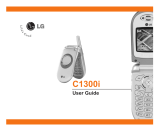
the FCC for each model. The highest SAR
value for this model phone when tested for
use at the ear is 0.084 W/kg (10g) and
when worn on the body, as described in this
user’s manual, is 0.029 W/kg (10g). (Body-
worn measurements differ amongphone
models, depending upon available
accessories and FCC requirements.) While
there may be differences between SAR levels
of various phones and at various positions,
they all meet the government requirement
for safe exposure.
Body-worn Operation
This device was tested for typical body-worn
operations with the back of the phone kept
0.6 inches (1.5cm) back of the phone.
between the user’s body and the back of the
phone. To comply with FCC RF exposure
requirements, a minimum separation distance
of 0.6 inches(1.5cm) s body and the back
must be maintained between the user s body
and the back of the phone. Third-party belt-
clips, holsters, and similar accessories
containing metallic components should not
be used. Body-worn accessories that cannot
maintain be used. Body-worn maintain 0.6
inches(1.5cm) separation distance between
the user s body and the back of the phone,
and have not been tested for typical body-
worn operations may not comply with FCC
RF exposure limits and should be avoided.
Product care and
maintenance
]
Do not disassemble this unit. Take it to a
qualified service technician when repair
work is required.
]
Keep away from electrical appliances such
as a TV's, radios or personal computers.
]
The unit should be kept away from heat
sources such as radiators or cookers.
]
Never place your phone in a microwave
oven as it will cause battery to explode.
WARNING!
Only use batteries, chargers and accessories
approved for use with this particular phone model.
The use of any other types may invalidate any
approval or warranty applying to the phone, and
may be dangerous.
Guidelines for safe and efficient use
Guidelines for safe and efficient use
10





















